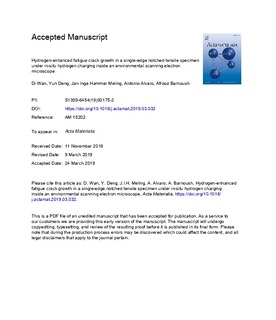| dc.contributor.author | Wan, Di | |
| dc.contributor.author | Deng, Yun | |
| dc.contributor.author | Meling, Jan Inge Hammer | |
| dc.contributor.author | Alvaro, Antonio | |
| dc.contributor.author | Barnoush, Afrooz | |
| dc.date.accessioned | 2019-04-24T11:08:30Z | |
| dc.date.available | 2019-04-24T11:08:30Z | |
| dc.date.created | 2019-04-17T10:28:44Z | |
| dc.date.issued | 2019 | |
| dc.identifier.citation | Acta Materialia. 2019, 170 87-99. | nb_NO |
| dc.identifier.issn | 1359-6454 | |
| dc.identifier.uri | http://hdl.handle.net/11250/2595263 | |
| dc.description.abstract | Fatigue crack growth (FCG) test was done on a pre-cracked single-edge notched tensile (SENT) specimen with oligocrystalline ferritic structure. Innovative in-situ hydrogen (H)- charging by plasma inside an environmental scanning electron microscope (ESEM) was adopted to directly observe the H influence on the FCG behavior of this material. Diverse in-situ and post-mortem characterization methods including secondary electron imaging, backscatter electron imaging, electron backscatter diffraction (EBSD) and scanning probe microscopy (SPM) were used to investigate the material's behavior. It was observed that the crack growth rate was enhanced by about one magnitude when H was charged, in comparison with the reference test in vacuum (Vac). The FCG procedure was concluded as strongly associated with the plasticity evolution in the vicinity of the crack-tip. A simple model based on the restricted plasticity was proposed for the H-enhanced FCG behavior. A peculiar frequency dependency of the H-enhanced FCG behavior was observed at low loading frequencies (0.015 Hz–0.15 Hz): under the same in-situ H-charging condition, a lower frequency gave a slower crack growth rate and vice versa. This behavior was explained by the thermally activated dislocation motion correlated with the plasticity shielding effect during crack growth. | nb_NO |
| dc.language.iso | eng | nb_NO |
| dc.publisher | Elsevier | nb_NO |
| dc.rights | Attribution-NonCommercial-NoDerivatives 4.0 Internasjonal | * |
| dc.rights.uri | http://creativecommons.org/licenses/by-nc-nd/4.0/deed.no | * |
| dc.title | Hydrogen-enhanced fatigue crack growth in a single-edge notched tensile specimen under in-situ hydrogen charging inside an environmental scanning electron microscope | nb_NO |
| dc.type | Journal article | nb_NO |
| dc.type | Peer reviewed | nb_NO |
| dc.description.version | acceptedVersion | nb_NO |
| dc.source.pagenumber | 87-99 | nb_NO |
| dc.source.volume | 170 | nb_NO |
| dc.source.journal | Acta Materialia | nb_NO |
| dc.identifier.doi | 10.1016/j.actamat.2019.03.032 | |
| dc.identifier.cristin | 1693039 | |
| dc.description.localcode | © 2019. This is the authors’ accepted and refereed manuscript to the article. Locked until 26 March 2021 due to copyright restrictions. This manuscript version is made available under the CC-BY-NC-ND 4.0 license http://creativecommons.org/licenses/by-nc-nd/4.0/ | nb_NO |
| cristin.unitcode | 194,64,92,0 | |
| cristin.unitname | Institutt for maskinteknikk og produksjon | |
| cristin.ispublished | true | |
| cristin.fulltext | postprint | |
| cristin.qualitycode | 2 | |

